Summary The Mara veterinary unit was involved in a number of activities during the month of February, these included treatment of a lionness whose liver popped out after being injured by a prey during hunting, replacement of an elephant collar and collaring another elephant in Mara Conservancy, sampling of 23 common zebras for theileriosis study among other activities
Summary
The Mara veterinary unit was involved in a number of activities during the month of February, these included treatment of a lionness whose liver popped out after being injured by a prey during hunting, replacement of an elephant collar and collaring another elephant in Mara Conservancy, sampling of 23 common zebras for theileriosis study among other activities. The veterinary unit in Masai Mara urgently requires adequate electricity to run a sample bank fridge in the camp, without which most of the samples will deteriorate before being analysed. All the veterinary activities went on successfully during the month as reported below.
Removal of a snare from a Maasai Giraffe in Mara Triangle
This was a case of snared young female giraffe. The snare was tightly cutting through the coronary band of the right front leg. It was a thick cable winch wire. The snare had caused a traumatic injury to the leg and the giraffe had become lame and could only limp, it was also under a great pain. The veterinary team intervened and captured the giraffe and removed the snare followed by treatment of the wound.
Immobilization and treatment
The giraffe was immobilized by use of a combination of etorphine (m99) and xylazine 12mgs and 30mgs respectively. The giraffe was effectively immobilized after six minutes and was roped down. The snare was cut off using a wire cutter and the wound cleaned and debrided to remove maggots and all the necrotic debris, topical treatment using antibiotic ointments and spray was also applied to enhance healing process. The animal was then treated with 40mls of 20% oxytetracycline antibiotic equivalent to 8g oxytetracycline.
Revival
The giraffe was then revived from anaesthesia using 36mgs of diprenorphine and 5mgs of atipamezole (antisedan) in one syringe given intravenously through the jugular vein. Prognosis after treatment is good as the irritating wire had been removed and injury treated.

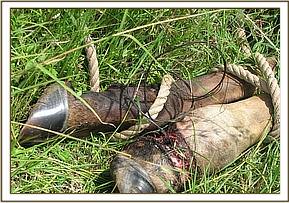
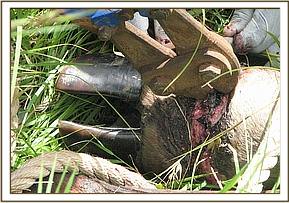
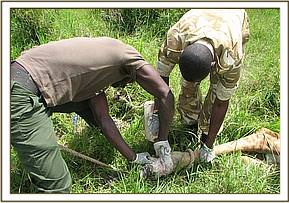


Treatment of a giraffe with an arrow stuck on the right abdomen in Mara Conservancy, Masai Mara.
This was a sub-adult female giraffe that had been sighted with a along metallic spear sticking on its right abdomen. The spear had pierced through the abdomen causing a lot of traumatic injuries to the abdominal organs. It had stayed in this condition for about 3 days before it was sighted. The animal was sighted by the Mara Conservancy rangers while on their regular patrol and reported the case to Mara veterinary unit for attention. It required an urgent veterinary attention to save it from the pain and injury caused by the spear.
Chemical immobilization and restrain
The giraffe was darted from a vehicle using 10mgs of etorphine hydrochloride combined with 30mgs of Xylazine hydrochloride. It took about 5 minutes to get narcotized and was then roped down manually. The spear was pulled out from the abdomen, the spear was smooth and slendor with no hook therefore it did not cause extensive injuries to the abdomen. The wound was drained, cleaned and treated with long-acting antibiotics, the giraffe was still strong and in a very good body condition. Blood samples were obtained from the jugular vein that will be analyzed for health monitoring purposes.
Anaesthesia revival
After removal of the long spear, the animal was revived from anaesthesia using 36mgs of diprenorphine hydrochloride combined with 10mgs of atipamezole hydrochloride administered through the jugular vein. It rose up after about 2 minutes and joined the rest of the herd nearby after a successful treatment. Prognosis was good after removing the spear and treating the wound.
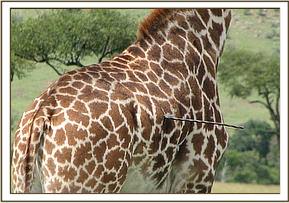
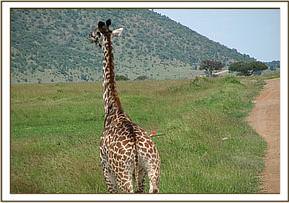
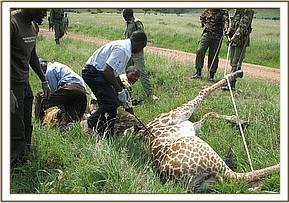
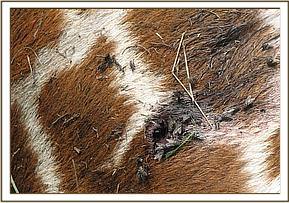
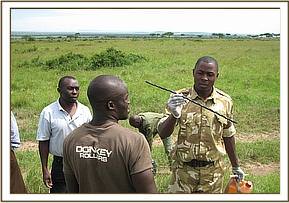

Collaring of elephants in Masai Mara
We captured and replaced a GPS collar of one of the male elephants (named Heritage,) that had previously been collared in Masai Mara. Its collar had failed to transmit GPS locations online due to expiry of battery and this made it difficult to track its movements in Mara. The same elephant was also treated for a long standing wound that was last attended to in June last year, however, the wound had regressed and the healing process was better. Another adult male elephant which was frequently involved in human-elephant conflict was also immobilized and fitted with a new collar in the same area. The other elephant was captured by darting from a helicopter and its collar removed after it caused an abrasive wound on the dorsal part of the neck. The wound was then treated and the elephant released. The main objectives of elephant collaring in Masai Mara is to enhance daily monitoring of elephant populations in the entire Masai Mara ecosystem in order to map out the elephant movement corridors and to reduce incidences of human-elephant conflict (HEC). The collars were designed to use satellite network and send GPS locations of elephants at an interval of 4 hours everyday for the next 5 years.
Revival of anaesthesia
After fitting the collar, the elephants were revived from anaesthesia using 48mgs of diprenorphine hydrochloride administered through the superficial ear-vein, the collaring exercise was quite successful and the elephant joined the rest of elephant herds without any complications. We are now able to track and get the GPS locations of the elephant daily. The elephant monitoring in Mara by use of GPS collars is done jointly by KWS, Mara North conservancy, Save The Elephants and David Sheldrick Wildlife Trust.

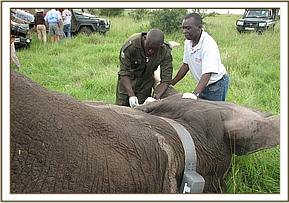

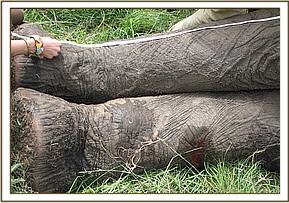
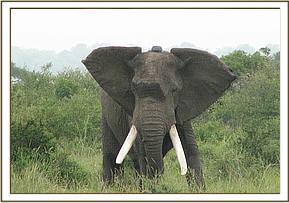

Sampling of common zebras (Equus burchellis) for theileriosis study in Masai Mara
This is a study that seeks to explore the role of zebras as reservoirs and transmission agents of Theileria species to other wildlife and livestock. A total of 23 common zebras were captured by darting from different herds well distributed across the Mara ecosystem. All the zebras were immobilized using a combination of etorphine and xylazine. After samples collection, the zebras were revived using a combination of diprenorphine and atipamezole administered through the jugular vein. Whole blood samples were collected in EDTA tubes, blood for serum was collected in plain tubes, tissue samples cut from the ear, hair samples also collected from tail switch. The samples will be subjected to molecular analysis to detect the presence of various Theileria species in free ranging zebras.


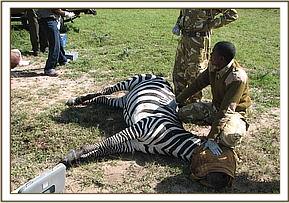
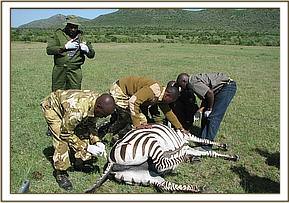

Treatment of an elephant with traumatic injury in Naiboshio conservancy
This was a case of a 15 year old male elephant in Naiboshio conservancy that had an extensive injury on the left front leg, the entire leg was heavily swollen and the elephant could not put weight on the affected leg, it exhibited carrying lameness. It was suspected to have developed arthritis after being hit by a sharp object. It had been treated for the injury 4 times without any recovery even though it had good appetite and drinking water appropriately. However, it later developed septiceamia and died due to heavy infection and swelling of the affected leg. A detailed postmortem examination revealed a complete fracture of the tibia bone at the stifle (knee joint). The fracture would not have been detected without an x-ray examination.

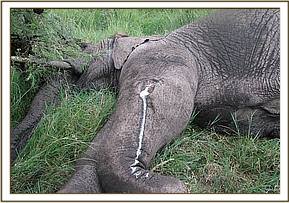


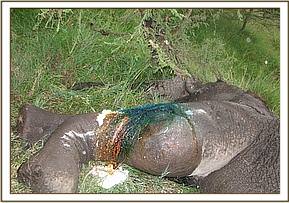
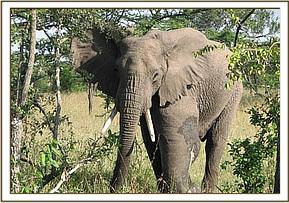
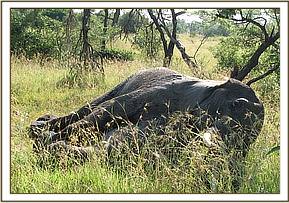
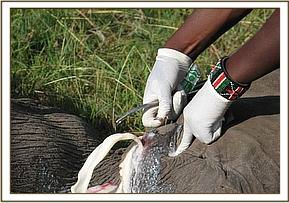
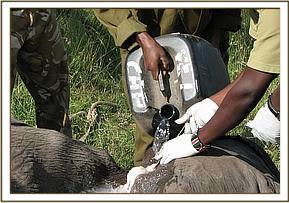
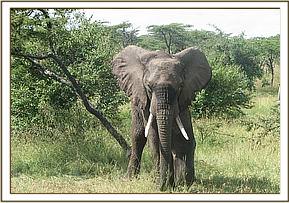

Treatment of an injured lionness in Maasai Mara NR
This was a case of lioness that got injured while hunting, the right part of the abdomen was stabbed by the horns of the prey and the liver popped out of the abdomen. The lioness was sighted 2 days after the injury and there was a lot of haemorrhage and the liver became necrotic. We intervened and replaced the liver back into the abdomen and sutured the wound.
Anaesthesia and treatment
Anaesthesia was achieved by use of 400mgs ketamine and 400mgs xylazine. After assessing the extent of the injury, it was discovered that the intestines were intact, the liver was torn at the base causing extensive haemorrhage from the hepatic vein. The area around the injury was shaved, cleaned and disinfected. The opening into the abdomen was enlarged and accumulated blood clots removed from the abdomen. The opening was extended to allow better assessment of the injury and ease of manipulation while returning the liver back to the abdomen. The liver was then cleaned by saline and antibiotic ointment applied on the surface to minimize infection, the entire surface of the liver had become necrotic but the parenchyma was still alive and the liver still had chances of regeneration. The liver was then replaced back into the abdomen.
After replacing back the liver, the peritoneum was closed using number -2 chromic-catgut suture using simple interrupted pattern, overlying muscles were similarly closed with same material with the subcutis. Skin was also closed with number 3 chromic-catgut which will be absorbed to avoid re-immobilization of the lioness to remove the sutures. Opticlox (cloxacillin) ointment was infused into the suture lines and antibiotic spray put on skin. The lionness was also covered with 8000mgs of amoxicillin and given 20mgs dexamethasone antinflammatory all given intramuscularly. Xylazine reversal was done after one hour by use of 50mgs atipamezole (antisedan).
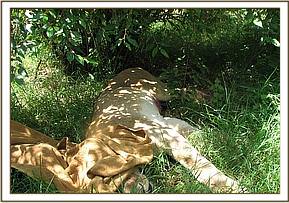
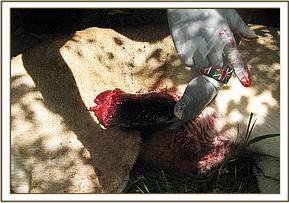
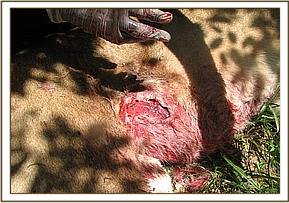


Acknowledgements
Kenya Wildlife Service (KWS) acknowledges the continous support of the David Sheldrick Wildlife Trust towards provision of wildlife veterinary services in Masai Mara ecosystem this has significantly contributed to the general wildlife health and conservation in the Mara ecosystem. We also acknowledge the support of the KWS rangers and staff from Masai Mara National Reserve, Mara North conservancy, Naiboshio conservancy, Mara Conservancy and the surrounding community-owned wildlife conservancies for continuous support and reporting of wildlife incidences requiring veterinary intervention in the Mara ecosystem.
Report by: Dr. Domnic Mijele